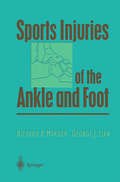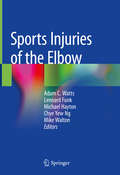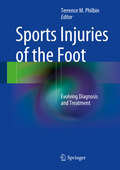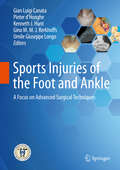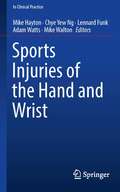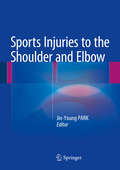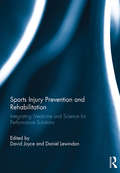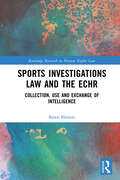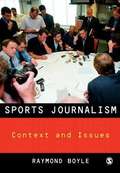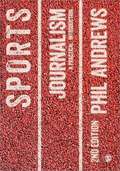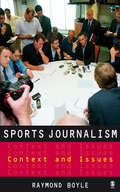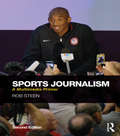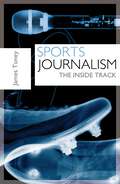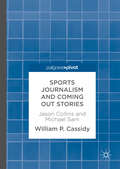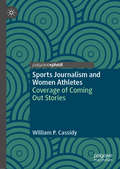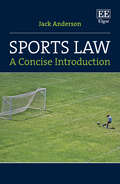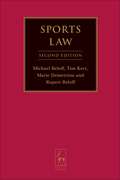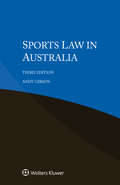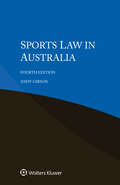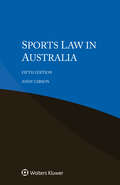- Table View
- List View
Sports Injuries of the Ankle and Foot
by Richard A. Marder George J. LianAs more internists and family physicians increase their scope to include sports medicine, this book reaches beyond the orthopaedic surgery market to provide a one-source reference for the treatment of both simple and complex sports-related injuries. For ease of use, the book is divided into the various anatomical sections: the forefoot, the midfoot, the hindfoot, the ankle, tendon disorders, and orthotics and braces - each enhanced by rehabilitation procedures and algorithms. It enables the physician to formulate a treatment plan and compare the various surgical and non-surgical options for a variety of injuries including: stress and other fractures, ankle instability, ruptures, sprain, ligament injuries, tendonitis, lesions, and neuropathies. The text is supported by copious illustrations, including 100 line drawings, 99 operative photos and a full-colour 4-page insert.
Sports Injuries of the Elbow
by Adam C. Watts Lennard Funk Michael Hayton Chye Yew Ng Mike WaltonThis book provides a concise guide to the diagnosis, investigations, surgical principles and post-operative rehabilitation to sports injuries of the elbow. It features guidance on best practice and information on the appropriate use of the latest diagnostic and therapeutic techniques. Injuries seen in athletes who participate in overhead and contact sports are discussed along with a range of other injury types. Relevant concepts in applied biomechanics and information on sport-specific rehabilitation are also covered enabling the reader to develop a deep understanding of how to develop appropriate treatment plans tailored to individual needs. Sports Injuries of the Elbow comprehensively covers the diagnosis and treatment of patients with elbow injuries acquired during sporting activities, and is an indispensable resource for all medical professionals seeking an up-to-date reference on how to diagnose and treat a range of sports injuries that affect the elbow.
Sports Injuries of the Foot: Evolving Diagnosis and Treatment
by Terrence M. PhilbinSports Injuries of the Foot is the go-to text for the management and treatment of foot injuries in athletes, demonstrating the current state-of-the-art techniques in assessment, testing and treatment. Organized anatomically beginning with the toes and working down the foot, it covers such common athletic injuries as turf toe, bunions, MTP instability and mid foot and navicular fractures, all in the context of athletic activity. Attention is also given to special considerations for the adolescent and female athlete, with an eye toward return to play. Written by clinicians for clinicians, it will be an invaluable resource for orthopedists, podiatrists, team physicians, athletic trainers and primary care providers alike.
Sports Injuries of the Foot and Ankle: A Focus on Advanced Surgical Techniques
by Gian Luigi Canata Kenneth J. Hunt Umile Giuseppe Longo Pieter D'Hooghe Gino M.M.J. KerkhoffsThis book explores in a comprehensive manner the best current treatment options for sports injuries of the foot and ankle. Particular attention is devoted to advanced surgical techniques, with practical and clear explanation of every step of the described procedures. The coverage encompasses management of the full range of ligament, bone and joint, and tendon injuries, and a concluding section addresses special considerations such as outcome assessment and advances in rehabilitation techniques. Foot and ankle injuries are extremely common in athletes and may endanger their sporting activity. The approach to these injuries is constantly evolving with the aim of achieving the best possible functional restoration. In presenting a state of the art update covering all aspects of treatment, this book will be of value for established foot and ankle surgeons, fellows and residents in orthopaedics, and all those involved in sports medicine. The authors are leading international experts renowned within their fields, and the book is published in collaboration with ISAKOS.
Sports Injuries of the Hand and Wrist (In Clinical Practice)
by Mike Hayton Chye Yew Ng Lennard Funk Adam Watts Mike WaltonThis book provides insights into sports medicine addressing trauma of the hand and wrist. This collection of injuries invites readers to trace aetiology, diagnosis, relevant pathology, management principles, and outcomes of numerous injuries in elite and non-elite athletes. The authors present management principles and outcomes. It is an ideal reference for postgraduate musculoskeletal doctors and therapists for Orthopaedic and Sports Medicine postgraduate degrees. Each approach to deal with an injury is underlined by case reports. Readers will also find valuable questions and answers fro self-assessment purpose. Sports Injuries of the Hand and Wrist is aimed at sports doctors, musculoskeletal doctors, senior orthopedic trainees with an interest in upper limb, orthopedic trainees preparing for the FRCSOrth exam and similar international exams, as well as upper hand and wrist surgeons in the earlier years of their practice.
Sports Injuries to the Shoulder and Elbow
by Jin-Young ParkThis book documents current knowledge on the mechanisms involved in sports injuries to the shoulder and elbow, reviews essential physical examinations, and explains the role of diagnostic imaging. Above all, it describes in detail the treatment modalities that are appropriate to the injuries encountered in throwing and overhead athletes, including chronic repetitive and acute traumatic injuries. Both conservative and surgical treatments are covered; the author’s own preferred operative techniques are identified and explained, and helpful treatment algorithms offer guidance in selecting an approach fitting to the circumstances. In addition, the inclusion of instructive case reviews will assist readers in achieving a full understanding of the implementation of treatment protocols. Methods of rehabilitation are also described with the aid of demonstration videos, and advice is provided on appropriate timing. The book will be invaluable for all professionals who deal with sports injuries of the shoulder and elbow, including surgeons, physiotherapists, other medical practitioners, and trainers.
Sports Injury Prevention and Rehabilitation: Integrating Medicine and Science for Performance Solutions
by David Joyce Daniel LewindonWorld-class rehabilitation of the injured athlete integrates best practice in sports medicine and physical therapy with training and conditioning techniques based on cutting-edge sports science. In this ground-breaking new book, leading sports injury and rehabilitation professionals, strength and conditioning coaches, biomechanists and sport scientists show how this integrated model works across the spectrum of athlete care. In every chapter, there is a sharp focus on the return to performance, rather than just a return to play. The book introduces evidence-based best practice in all the core areas of sports injury risk management and rehabilitation, including: performance frameworks for medical and injury screening; the science of pain and the psychology of injury and rehabilitation; developing core stability and flexibility; performance retraining of muscle, tendon and bone injuries; recovery from training and rehabilitation; end-stage rehabilitation, testing and training for a return to performance. Every chapter offers a masterclass from a range of elite sport professionals, containing best practice protocols, procedures and specimen programmes designed for high performance. No other book examines rehabilitation in such detail from a high performance standpoint. Sports Injury Prevention and Rehabilitation is essential reading for any course in sports medicine and rehabilitation, strength and conditioning, sports science, and for any clinician, coach or high performance professional working to prevent or rehabilitate sports injuries.
Sports Injury Prevention and Rehabilitation: Integrating Medicine and Science for Performance Solutions
by David Joyce Daniel LewindonWorld-class rehabilitation of the injured athlete integrates best practice in sports medicine and physical therapy with training and conditioning techniques based on cutting-edge sports science. In this ground-breaking new book, leading sports injury and rehabilitation professionals, strength and conditioning coaches, biomechanists and sport scientists show how this integrated model works across the spectrum of athlete care. In every chapter, there is a sharp focus on the return to performance, rather than just a return to play. The book introduces evidence-based best practice in all the core areas of sports injury risk management and rehabilitation, including: performance frameworks for medical and injury screening; the science of pain and the psychology of injury and rehabilitation; developing core stability and flexibility; performance retraining of muscle, tendon and bone injuries; recovery from training and rehabilitation; end-stage rehabilitation, testing and training for a return to performance. Every chapter offers a masterclass from a range of elite sport professionals, containing best practice protocols, procedures and specimen programmes designed for high performance. No other book examines rehabilitation in such detail from a high performance standpoint. Sports Injury Prevention and Rehabilitation is essential reading for any course in sports medicine and rehabilitation, strength and conditioning, sports science, and for any clinician, coach or high performance professional working to prevent or rehabilitate sports injuries.
Sports Investigations Law and the ECHR: Collection, Use and Exchange of Intelligence (Routledge Research in Human Rights Law)
by Björn HessertThis book focuses on the analysis of coercive measures that sports organisations are permitted to use as part of their internal sports investigation proceedings to investigate sports rule violations. The legality of such coercive measures is measured against the legal regime of the European Convention on Human Rights (ECHR). The book examines the important issue of the applicability of the ECHR to private sports organisations, which is currently widely debated in the field of sports law. The ECHR is hereby used as the analytical framework, which should also be a source of inspiration for jurisdictions outside the scope of application of the ECHR. The book further explores if and to what extent sports organisations and law enforcement agencies may exchange intelligence in support of both internal sports investigation proceedings and criminal investigations. At all stages, the work seeks to strike a balance between the interest of sports organisations to investigate sports rule violations and the rights of athletes and other sportspersons. The work will be an invaluable resource for students, academics and policy-makers working in the area of Sports Law and Human Rights Law.
Sports Investigations Law and the ECHR: Collection, Use and Exchange of Intelligence (Routledge Research in Human Rights Law)
by Björn HessertThis book focuses on the analysis of coercive measures that sports organisations are permitted to use as part of their internal sports investigation proceedings to investigate sports rule violations. The legality of such coercive measures is measured against the legal regime of the European Convention on Human Rights (ECHR). The book examines the important issue of the applicability of the ECHR to private sports organisations, which is currently widely debated in the field of sports law. The ECHR is hereby used as the analytical framework, which should also be a source of inspiration for jurisdictions outside the scope of application of the ECHR. The book further explores if and to what extent sports organisations and law enforcement agencies may exchange intelligence in support of both internal sports investigation proceedings and criminal investigations. At all stages, the work seeks to strike a balance between the interest of sports organisations to investigate sports rule violations and the rights of athletes and other sportspersons. The work will be an invaluable resource for students, academics and policy-makers working in the area of Sports Law and Human Rights Law.
Sports Journalism: Context and Issues
by Phil AndrewsAcross all media; print, broadcast as well as online, sports journalism has come to occupy an increasingly visible space. This book looks at the institutional, cultural and economic environment and provides an invaluable overview of contemporary sports journalism across all media forms.
Sports Journalism: A Practical Introduction (PDF)
by Phil AndrewsSports Journalism: A Practical Guide will give you the skills you need to navigate these new platforms, whilst also teaching you the basics of interviewing, reporting, feature writing for print and commentary for radio and television.
Sports Journalism
by Raymond Boyle"Boyle's study is essential reading for all students, teachers and researchers of sports journalism. " - Journalism "Very clear and accessible, addressing key and complex issues in a plain and clearcut way. " -Alan Tomlinson, University of Brighton Across all media; print, broadcast as well as online, sports journalism has come to occupy an increasingly visible space. This book looks at the institutional, cultural and economic environment and provides an invaluable overview of contemporary sports journalism across all media forms. The book: Situates sports journalism within the broader historical, economic, technological and cultural contexts. Examines the commercialisation of sport and the impact this is having on sports journalism. Looks at the relationship between PR and journalism. Considers the gendered nature of the industry and the impact of digital technology on professional practice.
Sports Journalism: A Multimedia Primer
by Rob SteenSports Journalism is a comprehensive guide to the purpose, principles and practice of this unique profession. Now in a fully revised and updated second edition, including important new material on social media and the rise of on-line journalism, this is still the only book to explore the fundamentals of sports reporting across every media platform. Combining an introduction to practical skills, contextual discussion of the changing media environment, and important case studies, including the ground-breaking story of Lance Armstrong, the book covers key topics such as: essential relationships in sports journalism - networking and the Sports Desk print journalism for magazines, tabloids, broadsheets and the internet live action – news, radio and television sports journalism effective research – managing and accessing sources, information, statistics practical skills for managing schedules and meeting deadlines working with sports agents and PR professionals getting the best from press conferences and interviews. Laced with revealing anecdotes from the author's own thirty years’ experience of domestic and international sport journalism, and including questions in each chapter to encourage critical reflection and notes on further reading, Sports Journalism is the ultimate insider’s guide and an invaluable student companion.
Sports Journalism: A Multimedia Primer
by Rob SteenSports Journalism is a comprehensive guide to the purpose, principles and practice of this unique profession. Now in a fully revised and updated second edition, including important new material on social media and the rise of on-line journalism, this is still the only book to explore the fundamentals of sports reporting across every media platform. Combining an introduction to practical skills, contextual discussion of the changing media environment, and important case studies, including the ground-breaking story of Lance Armstrong, the book covers key topics such as: essential relationships in sports journalism - networking and the Sports Desk print journalism for magazines, tabloids, broadsheets and the internet live action – news, radio and television sports journalism effective research – managing and accessing sources, information, statistics practical skills for managing schedules and meeting deadlines working with sports agents and PR professionals getting the best from press conferences and interviews. Laced with revealing anecdotes from the author's own thirty years’ experience of domestic and international sport journalism, and including questions in each chapter to encourage critical reflection and notes on further reading, Sports Journalism is the ultimate insider’s guide and an invaluable student companion.
Sports Journalism: The Inside Track
by James Toney'I always turn to the sport section first. The sport section record people's accomplishments; the front page nothing but man's failures.' - Earl Warren.Sports journalism, once dismissed as the 'toyshop' editorial department, has grown in importance as sport has become bigger and bigger business, generating billions in revenue to those who own teams, franchises, tournaments and organisations. Millions consume their newspapers from back to front and the audience for Britain's only 24 sports news channel more than eclipses news rivals.This book gives aspiring journalists and those reporters looking to move into sports journalism an inside track on what is needed to succeed in one of the most competitive media markets. Sports journalism is changing - the proliferation of dedicated TV channels, websites, radio stations, niche publications and, of course, newspapers offers a world of opportunity, but has also led to a change in the nature of the job.Drawing on the personal experiences of established and recently qualified reporters, it covers the whole range of skills required by sports journalists from traditional match reporting, news gathering, feature writing and colour copy to the modern demands such as providing a live blog, snaps for a website and updating a Twitter feed even before you getting around writing your story. You might be juggling the demands of a website that craves immediate SEO-friendly content with the requirements of a newspaper - which will still want the latest and freshest take on the story with a witty, punchy and original intro.Sport Journalism is an essential practical guide to sports journalism, focusing on the traditional key skills still required for success as a reporter but illustrating the increasing importance placed on multimedia, as print, online and broadcast journalism converge.
Sports Journalism: The Inside Track
by James Toney'I always turn to the sport section first. The sport section record people's accomplishments; the front page nothing but man's failures.' - Earl Warren.Sports journalism, once dismissed as the 'toyshop' editorial department, has grown in importance as sport has become bigger and bigger business, generating billions in revenue to those who own teams, franchises, tournaments and organisations. Millions consume their newspapers from back to front and the audience for Britain's only 24 sports news channel more than eclipses news rivals.This book gives aspiring journalists and those reporters looking to move into sports journalism an inside track on what is needed to succeed in one of the most competitive media markets. Sports journalism is changing - the proliferation of dedicated TV channels, websites, radio stations, niche publications and, of course, newspapers offers a world of opportunity, but has also led to a change in the nature of the job.Drawing on the personal experiences of established and recently qualified reporters, it covers the whole range of skills required by sports journalists from traditional match reporting, news gathering, feature writing and colour copy to the modern demands such as providing a live blog, snaps for a website and updating a Twitter feed even before you getting around writing your story. You might be juggling the demands of a website that craves immediate SEO-friendly content with the requirements of a newspaper - which will still want the latest and freshest take on the story with a witty, punchy and original intro.Sport Journalism is an essential practical guide to sports journalism, focusing on the traditional key skills still required for success as a reporter but illustrating the increasing importance placed on multimedia, as print, online and broadcast journalism converge.
Sports Journalism and Coming Out Stories: Jason Collins and Michael Sam
by William P. CassidyThis book examines how sports journalists covered the historic coming out stories of National Basketball Association (NBA) veteran Jason Collins and football All-American Michael Sam in the context of sports’ “toy department” reputation as a field whose standards are often criticized as lacking in rigor and depth compared to other forms of journalism. Employing a media sociology approach, reporting about Collins and Sam is addressed in the book via three content analysis studies and interviews with two prominent sports journalists. An overview of other pertinent research is provided along with a detailed account of both athletes’ stories. This work should appeal to readers interested in sports journalism, the role of sport in society, and media coverage of gay professional athletes.
Sports Journalism and Coming Out Stories: Jason Collins and Michael Sam
by William P. CassidyThis book examines how sports journalists covered the historic coming out stories of National Basketball Association (NBA) veteran Jason Collins and football All-American Michael Sam in the context of sports’ “toy department” reputation as a field whose standards are often criticized as lacking in rigor and depth compared to other forms of journalism. Employing a media sociology approach, reporting about Collins and Sam is addressed in the book via three content analysis studies and interviews with two prominent sports journalists. An overview of other pertinent research is provided along with a detailed account of both athletes’ stories. This work should appeal to readers interested in sports journalism, the role of sport in society, and media coverage of gay professional athletes.
Sports Journalism and Women Athletes: Coverage of Coming Out Stories
by William P. Cassidy“Women’s sports have typically been grossly under-represented in sports media coverage. Although elite lesbian athletes far outnumber ‘out’ male athletes, media scrutiny of their experiences remains largely non-existent. Largely situated in the context of improved cultural attitudes toward sexual minorities across the West, Bill Cassidy’s Sports Journalism and Women Athletes: Coverage of Coming Out Stories is, therefore, a valuable contribution to the study of sports journalism and media, offering – for the first time – a dedicated and detailed account of the coming out of some of sports’ most high-profile lesbian athletes.”- Dr. Rory Magrath, Solent University, UKThis book examines sports journalism coverage of the coming out stories of three prominent women athletes: tennis legend and feminist icon Billie Jean King, Basketball Hall of Fame Member Sheryl Swoopes and WNBA champion Brittney Griner. When King was outed in 1981 it marked a pivotal moment in which journalists were forced to discuss lesbian athletes in sports for the first time. Swoopes’ 2005 coming out was hailed as a historic moment due to her status as one of the best women’s basketball players of all time, while Griner’s casual public acknowledgment of her sexuality came during what many have called a more receptive environment for gay and lesbian athletes. By directly analysing and comparing the media attention given to these three superstars, Cassidy provides a comprehensive overview of how journalists have historically addressed women and lesbian athletes in professional sports. This book will appeal to readers interested in sports journalism, the role of sport in society, and media coverage of gay athletes.
Sports Law: A Concise Introduction
by Jack AndersonIn this essential primer on the key themes in sports law, Jack Anderson explains how law has become important to all aspects of sport, including participation, administration and the resolution of disputes. Crossing legal jurisdictions and sporting codes, it covers issues ranging from ambush marketing to broadcasting, corruption and doping.Analysing the broad range of actors and stakeholders involved in sport, this concise introduction illustrates how sports law, once the folly of contract law, now engages criminal, competition and international human rights law. The legal nuances to contemporary debates on concussion, the ‘gamblification’ of sport, the rights of transgender athletes, and sport’s flirtation with everything from cryptocurrencies to NFTs and private equity, all come into the orbit of this book. A departure point for further study in sports law, this book is also a reminder that sports law must be about fair play on, off and in court.An accessible, global approach to sports law, this book will be an invaluable companion for scholars and students of sports law worldwide. It will be equally beneficial to legal practitioners, journalists and those with an interest in sport generally.
Sports Law
by Michael Beloff Tim Kerr Marie Demetriou Rupert BeloffSports law has been growing with increasing rapidity over the years since the first edition of this book was published in 1999, regularly making headlines as well as leading to a developing body of law practised by specialist lawyers. This revised work, by leading practitioners in the field, with a foreword by Lord Coe, provides a coherent framework for understanding the principles of sports law in this area, as well as a deep analysis of its key features. The subject is split into various areas of practice: first, regulatory rules, which embrace the constitutional aspect of organised sport, including the disciplinary procedures of the various governing organisations; second, broadcasting and marketing resulting from the commercial exploitation, including sponsorship, of sports clubs, sporting events and players; and third, player's rights and obligations, which embraces a wide range of legal issues including club transfers and player contracts, and issues arising from employment (including discrimination law), personal injury and criminal law. Special attention is paid to the impact of EU and Human Rights law as well as to the influential jurisprudence of the Court of Arbitration for Sport. London 2012 provides an appropriate point at which to assess the current state of the law, as well as a look to the future. The target readership extends from solicitors, barristers and legal advisers, to sports organisations and clubs, corporations involved in marketing and sponsorship, media companies, academics teaching sports law, and sports administrators. “I commend it to everyone who has to administer sport as well as to those who have to advise the administrators or argue cases in the field on whatever side. It is a gold medal book.”From the Foreword by Lord Coe KBE
Sports Law in Australia
by Andy GibsonDerived from the renowned multi-volume International Encyclopaedia of Laws, this practical analysis of sports law in Australia deals with the regulation of sports activity by both public authorities and private sports organizations. The growing internationalization of sports inevitably increases the weight of global regulation, yet each country maintains its own distinct regime of sports law and its own national and local sports organizations. Sports law at a national or organizational level thus gains a growing relevance in comparative law. The book describes and discusses both state-created rules and autonomous self-regulation regarding the variety of economic, social, commercial, cultural, and political aspects of sports activities. Self- regulation manifests itself in the form of by-laws, and encompasses organizational provisions, disciplinary rules, and rules of play. However, the trend towards more professionalism in sports and the growing economic, social and cultural relevance of sports have prompted an increasing reliance on legal rules adopted by public authorities. This form of regulation appears in a variety of legal areas, including criminal law, labour law, commercial law, tax law, competition law, and tort law, and may vary following a particular type or sector of sport. It is in this dual and overlapping context that such much-publicized aspects as doping, sponsoring and media, and responsibility for injuries are legally measured. This monograph fills a gap in the legal literature by giving academics, practitioners, sports organizations, and policy makers access to sports law at this specific level. Lawyers representing parties with interests in Australia will welcome this very useful guide, and academics and researchers will appreciate its value in the study of comparative sports law.
Sports Law in Australia
by Andy Gibson<span style="mso-fareast-font-family:""; mso-bidi-font-family:"Times New Roman";mso-ansi-language:EN-GB">Derived from the renowned multi-volume <span style="mso-fareast-font-family:""; mso-bidi-font-family:"Times New Roman";mso-ansi-language:EN-GB">International Encyclopaedia of Laws<span style="mso-fareast-font-family:""; mso-bidi-font-family:"Times New Roman";mso-ansi-language:EN-GB">, this practical analysis of sports law in Australia deals with the regulation of sports activity by both public authorities and private sports organizations. The growing internationalization of sports inevitably increases the weight of global regulation, yet each country maintains its own distinct regime of sports law and its own national and local sports organizations. Sports law at a national or organizational level thus gains a growing relevance in comparative law. <span style="mso-fareast-font-family:"";mso-bidi-font-family:"Times New Roman"; mso-ansi-language:EN-GB">The book describes and discusses both state-created rules and autonomous self-regulation regarding the variety of economic, social, commercial, cultural, and political aspects of sports activities. Self- regulation manifests itself in the form of by-laws, and encompasses organizational provisions, disciplinary rules, and rules of play. However, the trend towards more professionalism in sports and the growing economic, social and cultural relevance of sports have prompted an increasing reliance on legal rules adopted by public authorities. This form of regulation appears in a variety of legal areas, including criminal law, labour law, commercial law, tax law, competition law, and tort law, and may vary following a particular type or sector of sport. It is in this dual and overlapping context that such much-publicized aspects as doping, sponsoring and media, and responsibility for injuries are legally measured. <span style="mso-fareast-font-family:"";mso-bidi-font-family:"Times New Roman"; mso-ansi-language:EN-GB">This monograph fills a gap in the legal literature by giving academics, practitioners, sports organizations, and policy makers access to sports law at this specific level. Lawyers representing parties with interests in Australia will welcome this very useful guide, and academics and researchers will appreciate its value in the study of comparative sports law.
Sports Law in Australia
by Andy GibsonDerived from the renowned multi-volume International Encyclopaedia of Laws, this practical analysis of sports law in Australia deals with the regulation of sports activity by both public authorities and private sports organizations. The growing internationalization of sports inevitably increases the weight of global regulation, yet each country maintains its own distinct regime of sports law and its own national and local sports organizations. Sports law at a national or organizational level thus gains a growing relevance in comparative law. The book describes and discusses both state-created rules and autonomous self-regulation regarding the variety of economic, social, commercial, cultural, and political aspects of sports activities. Self- regulation manifests itself in the form of by-laws, and encompasses organizational provisions, disciplinary rules, and rules of play. However, the trend towards more professionalism in sports and the growing economic, social and cultural relevance of sports have prompted an increasing reliance on legal rules adopted by public authorities. This form of regulation appears in a variety of legal areas, including criminal law, labour law, commercial law, tax law, competition law, and tort law, and may vary following a particular type or sector of sport. It is in this dual and overlapping context that such much-publicized aspects as doping, sponsoring and media, and responsibility for injuries are legally measured. This monograph fills a gap in the legal literature by giving academics, practitioners, sports organizations, and policy makers access to sports law at this specific level. Lawyers representing parties with interests in Australia will welcome this very useful guide, and academics and researchers will appreciate its value in the study of comparative sports law.
